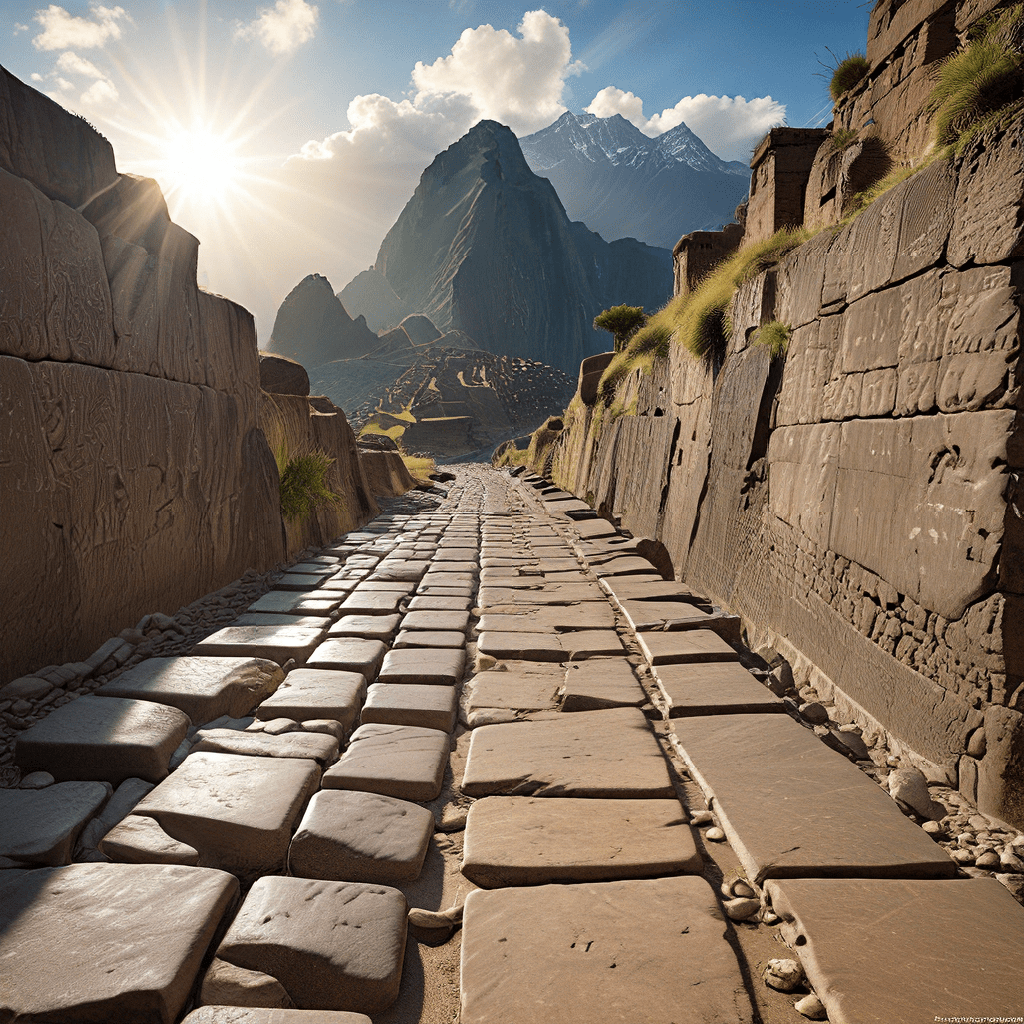The Incan Road System: A Legacy of Mystery and Marvel
The Incan road system, a vast network of pathways stretching across the rugged terrain of the Andes Mountains, stands as a testament to the engineering prowess and organizational skills of the Incan civilization. These roads, often carved into steep cliffs, winding through dense jungles, and traversing treacherous mountain passes, served as the lifeblood of the Incan Empire, connecting distant cities, facilitating trade, and enabling the swift movement of armies and messengers. The Incan roads are more than just ancient pathways; they are a window into the ingenuity, resourcefulness, and cultural identity of one of the most fascinating civilizations of the ancient world.
The Divine Origins of the Incan Roads: Legends and Myths
The Incan people, deeply connected to their environment and imbued with a profound reverence for nature, believed their roads were a gift from the gods, a testament to their divine blessing. Legends abound about the origins of these remarkable pathways. One such myth tells the story of Inti, the sun god, who, moved by the hardships faced by the Incan people, descended from the heavens to guide them in building these roads. The roads were believed to be a symbol of the Incan's connection to the divine, a physical manifestation of their spiritual beliefs.
In another myth, the roads are said to have been built by the mythical Viracocha, the creator god and father of the Inca people. He was said to have traveled the length and breadth of the land, leaving behind a path that would forever bind the Inca people together. These myths, passed down through generations, instilled a sense of awe and respect for the roads, cementing their place in the hearts and minds of the Incan people.
The Incan Empire’s Vision: A Network of Connectivity
The Incan Empire, at its peak, stretched across a vast expanse of land, encompassing mountains, valleys, and coastal plains. To effectively manage and control this expansive territory, the Incan rulers envisioned a network of roads that would connect the far-flung corners of their realm. These roads were not just for commerce and communication; they were a symbol of unity and power, a physical manifestation of the Incan Empire's ambition and reach.
The Incan road system was a marvel of planning and execution. It was designed with a practical purpose in mind: to facilitate the flow of goods, information, and people across the empire. The roads served as vital arteries, connecting the heart of the empire with its outlying provinces, ensuring the stability and prosperity of the Incan state.
The Construction of the Incan Roads: Engineering Principles and Techniques
The construction of the Incan roads was a monumental undertaking. The Incan engineers employed advanced techniques and meticulous planning to overcome the challenges posed by the rugged terrain. They used a combination of stone, earth, and wood to build their roads, carefully integrating them with the natural landscape.
One of the most remarkable features of the Incan roads was their impressive drainage systems. The Incas understood the importance of maintaining dry roads, especially during the rainy season. They skillfully incorporated drainage channels and culverts into the road construction, ensuring that water could flow freely, preventing erosion and damage to the roads. These drainage systems are a testament to the Incan engineers' understanding of basic hydrological principles and their ability to apply them to practical solutions.
The Role of Labor and Organization in Road Building
The construction of the Incan roads required a massive workforce, and the Incan people, known for their communal spirit and hierarchical social structure, devised a system of labor mobilization that allowed them to undertake these massive projects. The Incan government employed a system of labor called "mita," where all able-bodied citizens were obligated to work for the state for a specified period. This system ensured that there was a constant supply of labor for public works projects, including road construction.
The mita system, while essential for mobilizing labor, was also a crucial part of the Incan social and economic system. It provided opportunities for people from different parts of the empire to work together, fostering a sense of unity and shared purpose. It also served as a means of redistributing wealth throughout the empire, as those who worked on public projects were compensated with food, clothing, and other necessities.
Unveiling the Secrets of the Incan Roads: Archaeological Evidence and Research
Archaeologists and historians have been studying the Incan road system for centuries, uncovering fascinating details about its construction, purpose, and significance. Excavations have revealed evidence of the sophisticated engineering techniques employed by the Incas, such as the use of stone paving, drainage systems, and suspension bridges. These discoveries highlight the Incan’s understanding of materials, the environment, and the principles of construction.
Research has also shed light on the social and economic impact of the Incan road system. The roads facilitated trade, allowing goods to be transported between different regions of the empire. This helped to create a thriving economy and a network of interconnected communities. The roads also played a vital role in communication, allowing messages and orders to be relayed quickly and efficiently, which was crucial for managing a vast empire. Archeologists are also studying the remains of buildings and settlements along the Incan roads, providing valuable insight into the daily lives of the Incan people.
The Myth of the Incan Roads: Divine Intervention or Human Ingenuity?
The Incan roads have long been shrouded in myth and legend. Some people believe that these roads were built with the help of divine intervention, as they seem almost impossible to construct with the tools and technology available to the Incas. However, the evidence suggests otherwise. Archaeological findings and historical records point to the incredible skill and ingenuity of the Incan people.
The Incas possessed a deep understanding of their environment and a remarkable ability to adapt to challenging terrain. They used tools like stone hammers, chisels, and copper axes to carve roads through mountains and jungles, and they developed ingenious techniques for constructing bridges and retaining walls. While the Incas may have believed that their roads were a gift from the gods, their construction was a testament to human ingenuity and perseverance.
The Impact of the Incan Roads on Trade, Communication, and Empire Building
The Incan road system played a vital role in the growth and development of the Incan Empire. The roads facilitated trade, allowing goods such as textiles, ceramics, and precious metals to be transported between different regions of the empire. This led to a thriving economy and increased prosperity for the Incan people.
The roads also played a vital role in communication, allowing messages and orders to be relayed quickly and efficiently. This enabled the Incan rulers to maintain control over their vast empire. The Incan roads also allowed the Incan armies to move swiftly and efficiently, which helped them conquer new territories and maintain order within the empire. The Incan roads were a testament to the Incan empire's power, reach, and organizational skills.
The Incan Roads: A Testament to Cultural Identity and National Pride
The Incan roads were more than just pathways; they were a symbol of unity and national pride for the Incan people. They represented the connection between the Incas and their ancestors and their commitment to building a thriving society. The Incan roads embodied the Incan values of community, cooperation, and a deep respect for their environment.
Even after the fall of the Incan Empire, the roads have remained a source of inspiration and wonder. They serve as a reminder of the incredible achievements of the Incan civilization and their enduring legacy.
The Enduring Legacy of the Incan Roads: A Source of Inspiration and Wonder
The Incan roads continue to amaze and inspire people today. They are a testament to the ingenuity and resourcefulness of the Incan people. They also provide valuable insights into the history and culture of this fascinating civilization. The Incan roads are a valuable resource for archaeologists, historians, and travelers alike. They offer a glimpse into the past and a reminder of the enduring power of human achievement.
The Incan roads, a marvel of ancient engineering and a testament to human ingenuity, stand as a reminder of the Incan legacy and the enduring power of their civilization. These roads, a source of inspiration and wonder, continue to fascinate and intrigue people around the world.
FAQ
What materials did the Incas use to build their roads?
The Incas used a variety of materials to build their roads, including stone, earth, and wood. They often used stone for paving and retaining walls, earth for filling in gaps and leveling the roadbed, and wood for bridges and other structures.
How did the Incas transport materials for road construction?
The Incas used a variety of methods for transporting materials for road construction. They used llamas to carry smaller items, and they also developed a system of human carriers called "yanaconas" to transport larger objects. They also used a system of rollers to move heavy stones and timbers.
What was the purpose of the Incan road system?
The Incan road system served a variety of purposes, including facilitating trade, communication, and the movement of armies. The roads also helped to connect the Incan people and their culture and provided a means of transporting goods and resources across the vast Incan Empire.
What are some of the challenges the Incas faced when building their roads?
The Incas faced a number of challenges when building their roads, including the rugged terrain of the Andes Mountains, the harsh climate, and the lack of modern tools and technology. They also had to overcome the challenge of transporting materials over long distances.
How did the Incan road system impact the Incan Empire?
The Incan road system played a vital role in the growth and development of the Incan Empire. The roads facilitated trade, communication, and the rapid movement of armies. They also helped to connect the Incan people and their culture, and provided a means of transporting goods and resources across the vast Incan Empire.



